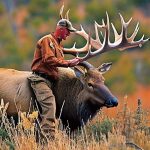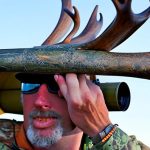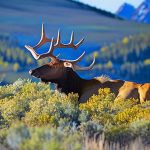Your cart is currently empty!

Unleashing the Thrill of Cow Elk Hunts: A Guide to an Unforgettable Experience

Cow elk hunting is a unique and exciting experience that offers hunters the opportunity to test their skills and immerse themselves in the beauty of the wilderness. As a hunter myself, I have had the privilege of embarking on several cow elk hunts, and each one has been a memorable adventure. The thrill of tracking and stalking these majestic animals, the challenge of outsmarting their keen senses, and the satisfaction of bringing home a bounty of delicious meat make cow elk hunting an experience like no other.
One particular cow elk hunt stands out in my memory. It was a crisp autumn morning, and I found myself perched on a ridge overlooking a vast expanse of forest. The sun was just beginning to rise, casting a golden glow on the landscape. As I sat there, patiently waiting for any sign of movement, I couldn’t help but feel a sense of anticipation and excitement. Little did I know that this hunt would be one of my most successful yet.
Key Takeaways
- Cow elk hunting is a unique and exciting experience that requires preparation and knowledge.
- Essential gear and equipment for cow elk hunting include a reliable rifle, appropriate clothing, and a good pair of boots.
- Finding the best hunting grounds for cow elk requires research and scouting, including looking for signs of elk activity.
- Understanding cow elk behavior, such as their feeding and mating habits, can increase the chances of a successful hunt.
- Hunting techniques for cow elk include spot and stalk, calling, and ambushing, but safety should always be a top priority.
Preparing for Your Cow Elk Hunt
Before embarking on a cow elk hunt, it is essential to ensure that you have all the necessary gear and equipment. A reliable rifle or bow, appropriate ammunition or arrows, and a good quality scope are all crucial for a successful hunt. Additionally, you will need proper clothing and footwear to keep you comfortable and concealed in the wilderness. Layered clothing is recommended to adapt to changing weather conditions, and sturdy boots with good traction are essential for navigating rugged terrain.
Packing for a cow elk hunt can be challenging, as you will need to carry all your gear and supplies with you. It is important to pack efficiently and prioritize essential items such as food, water, first aid kit, navigation tools, and emergency supplies. It is also advisable to bring camping gear if you plan on spending multiple days in the field. Remember to pack lightweight but nutritious meals that are easy to prepare in the wilderness.
Choosing the Right Hunting Grounds
Finding the right hunting grounds is crucial for a successful cow elk hunt. Researching and scouting potential locations beforehand can greatly increase your chances of encountering elk. Look for areas with a healthy elk population, ample food sources, and suitable terrain for stalking and tracking. National forests, state parks, and private lands with permission are all potential hunting grounds.
One effective way to find the best hunting grounds is to consult with local wildlife agencies or experienced hunters in the area. They can provide valuable insights into elk behavior and migration patterns, as well as recommend specific areas that have proven to be successful in the past. Online forums and hunting communities are also great resources for gathering information and connecting with fellow hunters.
Understanding the Behavior of Cow Elk
| Metrics | Description |
|---|---|
| Population Density | The number of cow elk per unit area |
| Mortality Rate | The percentage of cow elk that die each year |
| Reproductive Success | The percentage of cow elk that successfully give birth each year |
| Home Range Size | The area that a cow elk uses for feeding, resting, and other activities |
| Movement Patterns | The distance and direction that cow elk move throughout the year |
| Forage Availability | The amount and quality of food available to cow elk |
| Predator Presence | The presence and behavior of predators that may prey on cow elk |
To increase your chances of a successful cow elk hunt, it is important to understand the behavior of these magnificent animals. Cow elk are highly social creatures that live in herds led by a dominant female known as the matriarch. They have keen senses of smell, hearing, and sight, making them extremely alert and wary of their surroundings.
Cow elk are most active during the early morning and late afternoon hours, known as the “golden hours.” During these times, they are more likely to be feeding or moving from one location to another. Understanding their habits and routines can help you anticipate their movements and position yourself accordingly.
Hunting Techniques and Strategies
There are several hunting techniques and strategies that can be employed when pursuing cow elk. One popular technique is spot and stalk, where hunters locate elk from a distance and then carefully approach on foot for a shot opportunity. This technique requires patience, stealth, and good knowledge of the terrain.
Another effective strategy is calling, where hunters use various elk vocalizations to attract cows or bulls. This technique can be particularly successful during the rutting season when bulls are more responsive to calls. It is important to practice and master different elk calls to effectively mimic their sounds and lure them closer.
Ambushing is another technique that can be employed when hunting cow elk. This involves setting up in a strategic location, such as a feeding or bedding area, and waiting for elk to come within range. This technique requires careful scouting and knowledge of the elk’s behavior and movement patterns.
Safety Considerations for Cow Elk Hunting

Safety should always be a top priority when embarking on a cow elk hunt. The wilderness can be unpredictable, and it is important to take precautions to ensure your well-being. Before heading out, make sure to inform someone of your hunting plans, including your intended location and expected return time. Carry a reliable means of communication, such as a satellite phone or two-way radio, in case of emergencies.
It is also crucial to familiarize yourself with the hunting regulations and laws in the area you will be hunting. This includes obtaining the necessary licenses and permits, adhering to bag limits, and following any specific rules or restrictions. Respecting private property boundaries and obtaining permission from landowners is also essential.
Field Dressing and Processing Your Elk
Once you have successfully harvested a cow elk, it is important to field dress and process the animal properly to ensure the quality of the meat. Field dressing involves removing the internal organs and cooling the carcass as quickly as possible to prevent spoilage. This can be done by making an incision along the belly and carefully removing the organs.
After field dressing, it is important to transport the carcass to a cool location or a meat processing facility as soon as possible. If you are in a remote area, you may need to quarter the elk and pack out the meat on your own. It is crucial to keep the meat clean and cool during this process to prevent bacterial growth.
Cooking and Enjoying Your Elk Meat
One of the most rewarding aspects of cow elk hunting is the opportunity to enjoy the delicious meat that comes from the animal. Elk meat is lean, flavorful, and versatile, making it a favorite among hunters and chefs alike. There are countless recipes and meal ideas that can be prepared with elk meat, ranging from hearty stews and roasts to gourmet steaks and burgers.
When cooking elk meat, it is important to properly prepare and handle the meat to ensure optimal flavor and tenderness. Elk meat is best when cooked to medium-rare or medium doneness to prevent it from becoming tough and dry. Marinating the meat before cooking can also help enhance its flavor and tenderness.
Conservation and Ethical Hunting
As hunters, it is our responsibility to respect the wildlife and the environment in which we pursue our passion. Conservation efforts play a crucial role in maintaining healthy elk populations and preserving their habitats for future generations. It is important to support organizations and initiatives that work towards wildlife conservation and habitat preservation.
Ethical hunting practices are also essential for maintaining the integrity of the sport. This includes taking clean shots that result in a quick and humane kill, respecting bag limits and hunting regulations, and practicing fair chase principles. It is important to always hunt with respect for the animal and its environment.
Making the Most of Your Cow Elk Hunt
Cow elk hunting offers a unique opportunity to connect with nature, challenge yourself, and bring home a bounty of delicious meat. It is important to approach each hunt with a sense of gratitude and appreciation for the experience. Take the time to soak in the beauty of the wilderness, observe other wildlife, and reflect on the lessons learned from each hunt.
Whether you are a seasoned hunter or new to the sport, cow elk hunting can provide an unforgettable adventure. By preparing properly, understanding elk behavior, employing effective hunting techniques, prioritizing safety, and practicing ethical hunting practices, you can make the most of your cow elk hunting experience. So grab your gear, head into the wilderness, and embark on a cow elk hunt that will leave you with memories to last a lifetime.
If you’re interested in cow elk hunts, you might also want to check out this article on “How to Hunt Grouse Without a Dog” from Old Oak Syndicate. It provides valuable tips and techniques for hunting grouse without the assistance of a hunting dog. Whether you’re a beginner or an experienced hunter, this article offers insights that can help improve your grouse hunting skills. So, if you’re looking to expand your hunting knowledge beyond cow elk hunts, give it a read!
FAQs
What is a cow elk hunt?
A cow elk hunt is a type of hunting where hunters target female elk for meat.
When is the best time for cow elk hunting?
The best time for cow elk hunting varies depending on the location and season. Generally, it is during the fall season.
What is the difference between a cow elk and a bull elk?
A cow elk is a female elk, while a bull elk is a male elk. Cow elk are typically smaller in size and do not have antlers.
What is the purpose of cow elk hunting?
The purpose of cow elk hunting is to manage the elk population and provide a source of meat for hunters.
What equipment is needed for cow elk hunting?
Equipment needed for cow elk hunting includes a hunting rifle, ammunition, hunting boots, warm clothing, binoculars, and a hunting license.
Is cow elk hunting legal?
Cow elk hunting is legal in many states and countries, but regulations and requirements vary. Hunters should check with their local wildlife agency for specific rules and regulations.
What is the success rate for cow elk hunting?
The success rate for cow elk hunting varies depending on the location and hunting conditions. Generally, it is lower than bull elk hunting due to the smaller size and more cautious behavior of cow elk.

Herb has been a longtime lover of the outdoors. Whether it be hunting, camping, fishing or just getting outside to reset. Proud father and animal lover. Bourbon anyone?

by
Tags:
Comments

Categories
- Big Game Hunting (301)
- Deer (202)
- Reviews (3)
- Shooting (16)
- Slingshot (1)
- Small Game Hunting (42)
- Upland Hunting (126)
- Waterfowl Hunting (3)





Leave a Reply